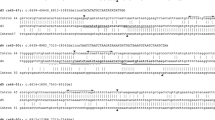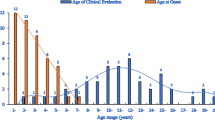Abstract
Mutations in the dystrophin gene (DMD) cause Duchenne and Becker muscular dystrophies and the majority of cases are due to DMD gene rearrangements. Despite the high incidence of these aberrations, little is known about their causative molecular mechanism(s). We examined 792 DMD/BMD clinical samples by oligonucleotide array-CGH and report on the junction sequence analysis of 15 unique deletion cases and three complex intragenic rearrangements to elucidate potential underlying mechanism(s). Furthermore, we present three cases with intergenic rearrangements involving DMD and neighboring loci. The cases with intragenic rearrangements include an inversion with flanking deleted sequences; a duplicated segment inserted in direct orientation into a deleted region; and a splicing mutation adjacent to a deletion. Bioinformatic analysis demonstrated that 7 of 12 breakpoints combined among 3 complex cases aligned with repetitive sequences, as compared to 4 of 30 breakpoints for the 15 deletion cases. Moreover, the inversion/deletion case may involve a stem-loop structure that has contributed to the initiation of this rearrangement. For the duplication/deletion and splicing mutation/deletion cases, the presence of the first mutation, either a duplication or point mutation, may have elicited the deletion events in an attempt to correct preexisting mutations. While NHEJ is one potential mechanism for these complex rearrangements, the highly complex junction sequence of the inversion/deletion case suggests the involvement of a replication-based mechanism. Our results support the notion that regional genomic instability, aided by the presence of repetitive elements, a stem-loop structure, and possibly preexisting mutations, may elicit complex rearrangements of the DMD gene.







Similar content being viewed by others
References
Armour JA, Sismani C, Patsalis PC, Cross G (2000) Measurement of locus copy number by hybridisation with amplifiable probes. Nucleic Acids Res 28:605–609
Bauters M, Van Esch H, Friez MJ, Boespflug-Tanguy O, Zenker M, Vianna-Morgante AM, Rosenberg C, Ignatius J, Raynaud M, Hollanders K, Govaerts K, Vandenreijt K, Niel F, Blanc P, Stevenson RE, Fryns JP, Marynen P, Schwartz CE, Froyen G (2008) Nonrecurrent MECP2 duplications mediated by genomic architecture-driven DNA breaks and break-induced replication repair. Genome Res 18:847–858
Cagliani R, Sironi M, Ciafaloni E, Bardoni A, Fortunato F, Prelle A, Serafini M, Bresolin N, Comi GP (2004) An intragenic deletion/inversion event in the DMD gene determines a novel exon creation and results in a BMD phenotype. Hum Genet 115:13–18
Campbell KP (1995) Three muscular dystrophies: loss of cytoskeleton–extracellular matrix linkage. Cell 80:675–679
Chance PF, Abbas N, Lensch MW, Pentao L, Roa BB, Patel PI, Lupski JR (1994) Two autosomal dominant neuropathies result from reciprocal DNA duplication/deletion of a region on chromosome 17. Hum Mol Genet 3:223–238
Chen KS, Manian P, Koeuth T, Potocki L, Zhao Q, Chinault AC, Lee CC, Lupski JR (1997) Homologous recombination of a flanking repeat gene cluster is a mechanism for a common contiguous gene deletion syndrome. Nat Genet 17:154–163
Chen L, Lee L, Kudlow BA, Dos Santos HG, Sletvold O, Shafeghati Y, Botha EG, Garg A, Hanson NB, Martin GM, Mian IS, Kennedy BK, Oshima J (2003) LMNA mutations in atypical Werner’s syndrome. Lancet 362:440–445
Cox GF, Kunkel LM (1997) Dystrophies and heart disease. Curr Opin Cardiol 12:329–343
Darras B, Korf BR, Urion DK (2008) Dystrophinopathies. In: GeneReviews at GeneTests (database online). http://www.genetests.org. University of Washington, Seattle, WA
del Gaudio D, Yang Y, Boggs BA, Schmitt ES, Lee JA, Sahoo T, Pham HT, Wiszniewska J, Chinault AC, Beaudet AL, Eng CM (2008) Molecular diagnosis of Duchenne/Becker muscular dystrophy: enhanced detection of dystrophin gene rearrangements by oligonucleotide array-comparative genomic hybridization. Hum Mutat 29:1100–1107
Den Dunnen JT, Grootscholten PM, Bakker E, Blonden LA, Ginjaar HB, Wapenaar MC, van Paassen HM, van Broeckhoven C, Pearson PL, van Ommen GJ (1989) Topography of the Duchenne muscular dystrophy (DMD) gene: FIGE and cDNA analysis of 194 cases reveals 115 deletions and 13 duplications. Am J Hum Genet 45:835–847
Ellis NA, Groden J, Ye TZ, Straughen J, Lennon DJ, Ciocci S, Proytcheva M, German J (1995) The Bloom’s syndrome gene product is homologous to RecQ helicases. Cell 83:655–666
Ellis NA, Ciocci S, German J (2001) Back mutation can produce phenotype reversion in Bloom syndrome somatic cells. Hum Genet 108:167–173
Ervasti JM (2007) Dystrophin, its interactions with other proteins, and implications for muscular dystrophy. Biochim Biophys Acta 1772:108–117
Finsterer J, Stollberger C (2003) The heart in human dystrophinopathies. Cardiology 99:1–19
Gu W, Zhang F, Lupski JR (2008) Mechanisms for human genomic rearrangements. Pathogenetics 1:4
Hegde MR, Chin EL, Mulle JG, Okou DT, Warren ST, Zwick ME (2008) Microarray-based mutation detection in the dystrophin gene. Hum Mutat 29:1091–1099
Helleday T (2003) Pathways for mitotic homologous recombination in mammalian cells. Mutat Res 532:103–115
Helleday T, Arnaudeau C, Jenssen D (1998) A partial hprt gene duplication generated by non-homologous recombination in V79 Chinese hamster cells is eliminated by homologous recombination. J Mol Biol 279:687–694
Hoffman EP, Brown RH Jr, Kunkel LM (1987) Dystrophin: the protein product of the Duchenne muscular dystrophy locus. Cell 51:919–928
Hoogerwaard EM, van der Wouw PA, Wilde AA, Bakker E, Ippel PF, Oosterwijk JC, Majoor-Krakauer DF, van Essen AJ, Leschot NJ, de Visser M (1999) Cardiac involvement in carriers of Duchenne and Becker muscular dystrophy. Neuromuscul Disord 9:347–351
Hu XY, Burghes AH, Ray PN, Thompson MW, Murphy EG, Worton RG (1988) Partial gene duplication in Duchenne and Becker muscular dystrophies. J Med Genet 25:369–376
Ibraghimov-Beskrovnaya O, Ervasti JM, Leveille CJ, Slaughter CA, Sernett SW, Campbell KP (1992) Primary structure of dystrophin-associated glycoproteins linking dystrophin to the extracellular matrix. Nature 355:696–702
Inoue K, Osaka H, Thurston VC, Clarke JT, Yoneyama A, Rosenbarker L, Bird TD, Hodes ME, Shaffer LG, Lupski JR (2002) Genomic rearrangements resulting in PLP1 deletion occur by nonhomologous end joining and cause different dysmyelinating phenotypes in males and females. Am J Hum Genet 71:838–853
Koenig M, Kunkel LM (1990) Detailed analysis of the repeat domain of dystrophin reveals four potential hinge segments that may confer flexibility. J Biol Chem 265:4560–4566
Koenig M, Monaco AP, Kunkel LM (1988) The complete sequence of dystrophin predicts a rod-shaped cytoskeletal protein. Cell 53:219–228
Kraus E, Leung WY, Haber JE (2001) Break-induced replication: a review and an example in budding yeast. Proc Natl Acad Sci USA 98:8255–8262
Lalic T, Vossen RH, Coffa J, Schouten JP, Guc-Scekic M, Radivojevic D, Djurisic M, Breuning MH, White SJ, den Dunnen JT (2005) Deletion and duplication screening in the DMD gene using MLPA. Eur J Hum Genet 13:1231–1234
Lee JA, Carvalho CM, Lupski JR (2007) A DNA replication mechanism for generating nonrecurrent rearrangements associated with genomic disorders. Cell 131:1235–1247
Lipson D, Aumann Y, Ben-Dor A, Linial N, Yakhini Z (2006) Efficient calculation of interval scores for DNA copy number data analysis. J Comput Biol 13:215–228
Lupski JR (2007) Genomic rearrangements and sporadic disease. Nat Genet 39:S43–S47
Madden HR, Fletcher S, Davis MR, Wilton SD (2009) Characterization of a complex Duchenne muscular dystrophy-causing dystrophin gene inversion and restoration of the reading frame by induced exon skipping. Hum Mutat 30:22–28
Nobile C, Galvagni F, Marchi J, Roberts R, Vitiello L (1995) Genomic organization of the human dystrophin gene across the major deletion hot spot and the 3′ region. Genomics 28:97–100
Nobile C, Toffolatti L, Rizzi F, Simionati B, Nigro V, Cardazzo B, Patarnello T, Valle G, Danieli GA (2002) Analysis of 22 deletion breakpoints in dystrophin intron 49. Hum Genet 110:418–421
Ohshima A, Inouye S, Inouye M (1992) In vivo duplication of genetic elements by the formation of stem-loop DNA without an RNA intermediate. Proc Natl Acad Sci USA 89:1016–1020
Oudet C, Hanauer A, Clemens P, Caskey T, Mandel JL (1992) Two hot spots of recombination in the DMD gene correlate with the deletion prone regions. Hum Mol Genet 1:599–603
Pentao L, Wise CA, Chinault AC, Patel PI, Lupski JR (1992) Charcot–Marie–Tooth type 1A duplication appears to arise from recombination at repeat sequences flanking the 1.5 Mb monomer unit. Nat Genet 2:292–300
Sheen CR, Jewell UR, Morris CM, Brennan SO, Ferec C, George PM, Smith MP, Chen JM (2007) Double complex mutations involving F8 and FUNDC2 caused by distinct break-induced replication. Hum Mutat 28:1198–1206
Sironi M, Pozzoli U, Comi GP, Riva S, Bordoni A, Bresolin N, Nag DK (2006) A region in the dystrophin gene major hot spot harbors a cluster of deletion breakpoints and generates double-strand breaks in yeast. FASEB J 20:1910–1912
Stankiewicz P, Shaw CJ, Dapper JD, Wakui K, Shaffer LG, Withers M, Elizondo L, Park SS, Lupski JR (2003) Genome architecture catalyzes nonrecurrent chromosomal rearrangements. Am J Hum Genet 72:1101–1116
Toffolatti L, Cardazzo B, Nobile C, Danieli GA, Gualandi F, Muntoni F, Abbs S, Zanetti P, Angelini C, Ferlini A, Fanin M, Patarnello T (2002) Investigating the mechanism of chromosomal deletion: characterization of 39 deletion breakpoints in introns 47 and 48 of the human dystrophin gene. Genomics 80:523–530
White SJ, Aartsma-Rus A, Flanigan KM, Weiss RB, Kneppers AL, Lalic T, Janson AA, Ginjaar HB, Breuning MH, den Dunnen JT (2006) Duplications in the DMD gene. Hum Mutat 27:938–945
Woodward KJ, Cundall M, Sperle K, Sistermans EA, Ross M, Howell G, Gribble SM, Burford DC, Carter NP, Hobson DL, Garbern JY, Kamholz J, Heng H, Hodes ME, Malcolm S, Hobson GM (2005) Heterogeneous duplications in patients with Pelizaeus-Merzbacher disease suggest a mechanism of coupled homologous and nonhomologous recombination. Am J Hum Genet 77:966–987
Zuker M (2003) Mfold web server for nucleic acid folding and hybridization prediction. Nucleic Acids Res 31:3406–3415
Acknowledgments
We thank Dr. Svetlana A. Yatsenko for helpful discussions and Ms. Weihong Jin and Ms. Hoang Pham for their technical assistance.
Author information
Authors and Affiliations
Corresponding author
Rights and permissions
About this article
Cite this article
Oshima, J., Magner, D.B., Lee, J.A. et al. Regional genomic instability predisposes to complex dystrophin gene rearrangements. Hum Genet 126, 411–423 (2009). https://doi.org/10.1007/s00439-009-0679-9
Received:
Accepted:
Published:
Issue Date:
DOI: https://doi.org/10.1007/s00439-009-0679-9




